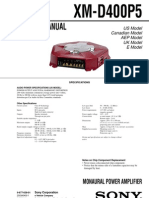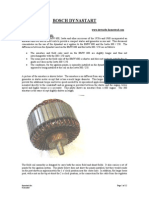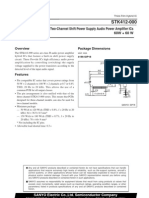Relay Diagrams
Relay Diagrams
Uploaded by
stainless31620039126Copyright:
Available Formats
Relay Diagrams
Relay Diagrams
Uploaded by
stainless31620039126Copyright
Available Formats
Share this document
Did you find this document useful?
Is this content inappropriate?
Copyright:
Available Formats
Relay Diagrams
Relay Diagrams
Uploaded by
stainless31620039126Copyright:
Available Formats
Connecting Additional Devices to the Remote Turn on Wire
Using a 30 amp SPDT relay, connect terminal #87 to constant 12 volts positive with a fuse rated to the sum of the additional accessories you've added and the components you need to turn on. (If you have two fans rated at 5 amps each and a neon light rated at 10 amps, you would use a 20 amp fuse plus 200 ma for each amplifier and processor.) Connect terminal #85 to ground, terminal #86 to the remote turn on wire from the head unit, and terminal #30 to each accessory with an appropriate fuse. A fuse (not shown) could also be used between the output of the relay (#30) and the remote turn on wire of the amplifiers and/or processors for extra precaution.
Constant to Momentary Output - Negative Input/Negative Output
The capacitor allows the coil of the relay to be energized until the capacitor stores a charge, thus deenergizing the coil. The resistor bleeds off the charge of the capacitor when positive voltage is removed from the other side of the coil. You can increase the output time by simply changing the value of the capacitor. This one will give you about a 1/2 second output.
Constant to Momentary Output - Negative Input/Positive Output
The capacitor allows the coil of the relay to be energized until the capacitor stores a charge, thus deenergizing the coil. The resistor bleeds off the charge of the capacitor when positive voltage is removed from the other side of the coil. You can increase the output time by simply changing the value of the capacitor. This one will give you about a 1/2 second output.
Constant to Momentary Output - Positive Input/Negative Output The capacitor allows the coil of the relay to be energized until the capacitor stores a charge, thus deenergizing the coil. The resistor bleeds off the charge of the capacitor when positive voltage is removed from the other side of the coil. You can increase the output time by simply changing the value of the capacitor. This one will give you about a 1/2 second output.
Constant to Momentary Output - Positive Input/Positive Output
The capacitor allows the coil of the relay to be energized until the capacitor stores a charge, thus deenergizing the coil. The resistor bleeds off the charge of the capacitor when positive voltage is removed from the other side of the coil. You can increase the output time by simply changing the value of the capacitor. This one will give you about a 1/2 second output.
Convert a Negative Output to a Positive Output
If you have a switch or an alarm or keyless entry that has a negative output that you wish to use to switch a device that requires 12V+ such as a horn, dome light, parking lights, head lights, hatch release, etc., wire a relay as shown below to convert the negative output (trigger) to a positive output.
Convert a Positive Output to a Negative Output
If you have a switch or an alarm or keyless entry that has a positive output that you wish to use to switch a device that requires a ground such as a horn, dome light, parking lights, head lights, hatch release, etc., wire a relay as shown below to convert the positive output (trigger) to a negative output.
Door Locks - 3 Wire Positive
This is one of the most common type of door lock switch configurations found in most vehicles. In most cases you will not need to add relays for this type. Most of the newer alarms and keyless entries on the market today have both positive and negative 200 ma door lock outputs that are usually capable of activating the factory relays. Should you need to add relays for a "3 wire negative" door lock system, just change both normally open terminals (87) from 12V(+) to ground. If your alarm or keyless entry has positive outputs only, you will have to connect the other side of the coils to ground and connect your outputs as shown. The lock and unlock wires below refer to the switch wires, not the motor legs.
Door Locks - 4 Wire Reversal
In this case, both motor legs of the door locks are normally open. They neither rest at ground or 12v(+). The switch, when moved in either direction, applies both power and ground directly to them without the use of any relays.
Door Locks - 5 Wire Alternating 12 Volts Positive
The switch, when moved in either direction, applies both power and ground directly to motor legs without the use of any relays. Except, at the switch in this case, both motor legs rest at ground . Therefore it is only necessary to change the polarity of one motor leg to lock or unlock the vehicle.
Door Locks - Actuators / Reverse Polarity - Negative Switch/Trigger (a)
This is practically identical to the 5 wire alternating 12V(+) system. The only difference is there's no switch. Both motor legs rest at ground at the relays. To lock or unlock the vehicle, polarity is changed on one motor leg via a negative pulse to the coil of the respective relay.
Door Locks - Actuators / Reverse Polarity - Negative Switch/Trigger (b)
Both motor legs rest at ground at the relays. To lock or unlock the vehicle, polarity is changed on one motor leg via a negative pulse from a switch, alarm, keyless entry, etc. to the coil of the respective relay.
Door Locks - Actuators / Reverse Polarity - Positive Switch/Trigger Both motor legs rest at ground at the relays. To lock or unlock the vehicle, polarity is changed on one motor leg via a positive pulse from a switch, alarm, keyless entry, etc. to the coil of the respective relay.
Door Locks - Add Auto Lock without an Alarm or Keyless Entry System You can easily add the convenience of auto lock to any vehicle equipped with power locks without adding a keyless entry or alarm ( or if the one you have does not have this feature). Please notice the relay on the left. This is an inhibit to prevent the doors from locking the customer out of his vehicle. When the key is turned to the "ignition on" position, the doors will only lock automatically if the doors are closed. If the vehicle has a positive door trigger, change terminal #85 of the left relay to ground and connect the door trigger to #86 as shown. For more info, click here.
Door Locks - Add Auto Unlock without an Alarm or Keyless Entry System Like the Auto Lock relay configuration, you can add auto unlock to any vehicle equipped with power locks. Just connect the output of this circuit to the vehicle's door unlock circuit using the appropriate application.
Door Locks - Dodge Caravan (1996 - 2000) Locate the white w/green wire in the harness under the body control module. When ground is applied to this wire through a 1.5 K ohm resistor the doors will lock. When ground is applied to this wire through a 249 ohm resistor the doors will unlock. Often it is necessary to provide a stronger ground than the negative output of an alarm or keyless entry can provide. When this is the case, use the following relay diagram found here as needed for lock and/or unlock.
Door Locks - Dodge Caravan (2001 - 2005) Locate the purple/green wire in connector 3, pin 21 at the body control module. When ground is applied to this wire through a 5.3 K ohm resistor the doors will lock. When ground is applied to this wire through a 2 K ohm resistor the doors will unlock. Often it is necessary to provide a stronger ground than the negative output of an alarm or keyless entry can provide. When this is the case, use the following relay diagram found here as needed for lock and/or unlock.
Door Locks - Ford Probe Locate the single wire from the switch. When (+) 12 VDC is applied to this wire the doors will lock. When (+) 12 VDC is applied through a 4.7 K ohm resistor, the doors will unlock. If your alarm or keyless entry has positive outputs, connect the resistor in series to the lock output wire with a diode and another diode to the unlock output with the cathodes of each towards the single lock/unlock wire.
Door Locks - Nissan Maxima 1995 - 1997, Double Ground Pulse Relay Diagram If this vehicle has a factory security system, a double ground pulse to the Green/Yellow (factory disarm wire) wire will unlock all doors. Brown wire will only unlock driver's door (alternating 12 V+). Pulse(-) to Lt. Green/Red will lock all doors.
Door Locks - Nissan's Single Wire '91-'95 using 1 relay and 1 diode (Type F door lock) On the '91-'95 300ZX and the '92-'95 240SX, locate the lock/unlock wire in the driver's kick panel or door jamb. When this wire is cut, or opened, the doors will lock. When this wire is grounded. the doors will unlock.
Door Locks - Nissan's Single Wire '91-'95 using 2 relays (Type F door lock) On the '91-'95 300ZX and the '92-'95 240SX, locate the lock/unlock wire in the driver's kick panel or door jamb. When this wire is cut, or opened, the doors will lock. When this wire is grounded. the doors will unlock. If you have positive door lock outputs from the alarm or keyless entry, connect the sides of the coils shown connected to (+)12 VDC to ground and the positive door lock outputs to the respective terminals of the relays.
Door Locks - Single Pulse to Lock and Unlock - Negative Pulse Using a mechanical latching relay like the PCB latching relay pictured here, you can use a single negative output to alternately lock and unlock the doors. The mechanical latching relay only requires it's coil to be momentarily energized to change and maintain the opening or closing of it's contacts. The SPDT relay will provide a dedicated negative output for lock when the coil is energized and a dedicated output for unlock when it is not energized.
Door Locks - Single Pulse to Lock and Unlock - Positive Pulse Using a mechanical latching relay like the PCB latching relay pictured here, you can use a single positive output to alternately lock and unlock the doors. The mechanical latching relay only requires it's coil to be momentarily energized to change and maintain the opening or closing of it's contacts. The SPDT relay will provide a dedicated positive output for lock when the coil is energized and a dedicated output for unlock when it is not energized.
Door Locks - Toyota with Child Safety Door Lock System Locate the child safety wire in the same harness as the lock and unlock wires. This wire will be different colors in different models and will show ground until the lock from the switch is activated. This is a three wire system with an additional wire that must see ground during unlock for all of the doors to unlock. An additional relay may not be required. This will depend on the outputs of your unit. If not needed, connect the unlock output to the wires shown on terminal #30.
Door Locks - Vacuum Type Found mostly on Mercedes Benz vehicles, the movement of the door lock actuators is controlled by a central vacuum pump. The switch changes polarity on a single wire that may rest at power or ground depending on the state of the door locks. You can duplicate this with at least a 2 second pulse. If the alarm or keyless entry you are installing does not have a 2 second or longer duration option for the door lock outputs, do not use this diagram (it will not work unless you incorporate a timer into this circuit).
GM Vehicle Anti-Theft System Passkey GM VATS Known Wire Color Combinations: These are most often found inside Orange Sheathing coming from the Ignition Switch. Yellow and Yellow White and White White, Yellow, and Black Red/White, Yellow, and Orange/Black Yellow and Brown Purple and Purple/White White/Black and Purple/Yellow White/Black and Purple/White GM Resistor Values: 392 Ohms 525 Ohms 680 Ohms 890 Ohms 1.13 K Ohms
1.47 K Ohms 1.80 K Ohms 2.37 K Ohms 3.00 K Ohms 3.74 K Ohms
4.75 K Ohms 6.00 K Ohms 7.50 K Ohms 9.53 K Ohms 11.8 K Ohms
GM Vehicle Anti-Theft System - Passkey II GM VATS Known Wire Color Combinations: These are most often found inside Orange Sheathing coming from the Ignition Switch. Yellow and Yellow White and White White, Yellow, and Black Red/White, Yellow, and Orange/Black Yellow and Brown Purple and Purple/White White/Black and Purple/Yellow White/Black and Purple/White GM Resistor Values: 392 Ohms 525 Ohms 680 Ohms 890 Ohms 1.13 K Ohms
1.47 K Ohms 1.80 K Ohms 2.37 K Ohms 3.00 K Ohms 3.74 K Ohms
4.75 K Ohms 6.00 K Ohms 7.50 K Ohms 9.53 K Ohms 11.8 K Ohms
Headlights and Parking Lights on with Wipers - Negative Input/Positive Output In many states, if not all, the law requires the vehicle's headlights and parking lights to be on anytime the vehicle's wipers are on. If you need to supply ground to either the headlights or parking lights, connect terminal 30 to ground on the respective relay.
Headlights and Parking Lights on with Wipers - Positive Input/Positive Output In many states, if not all, the law requires the vehicle's headlights and parking lights to be on anytime the vehicle's wipers are on. If you need to supply ground to either the headlights or parking lights, connect terminal 30 to ground on the respective relay.
Illuminated Entry for Vehicles with Negative Door Triggers When you unlock or disarm your vehicle with an alarm or keyless and have an output (usually 30 - 60 seconds long), and have negative door triggers, the output is connected to a relay as shown.
Illuminated Entry for Vehicles with Positive Door Triggers When you unlock or disarm your vehicle with an alarm or keyless and have an output (usually 30 - 60 seconds long), and have positive door triggers, the output is connected to a relay as shown
Latched On/Off Output Using a Single Momentary Negative Pulse - Positive Output Similar to the momentary to constant configuration, we can engage and disengage the latched output with a single pulse from a switch or an output from an alarm or remote keyless entry. The first pulse from the switch will engage the latch. The next pulse from the switch will disengage the latch. A negative output from an alarm, remote keyless entry, or other device can be used in place of the switch.
Latched On/Off Output Using a Single Momentary Negative Pulse - Positive Output - No Diodes Similar to the momentary to constant configuration, we can engage and disengage the latched output with a single pulse from a switch or an output from an alarm or remote keyless entry. The first pulse from the switch will engage the latch. The next pulse from the switch will disengage the latch. A negative output from an alarm, remote keyless entry, or other device can be used in place of the switch.
Latched On/Off Output Using Two Momentary Negative Pulses - Negative Output Once activated by the relay on the left, the relay's coil in the middle will stay energized providing a negative output until ground to the coil of the relay is broken by the relay on the right.
Latched On/Off Output Using Two Momentary Negative Pulses - Positive Output Once activated by the relay on the left, the relay's coil in the middle will stay energized providing a 12V(+) output until ground to the coil of the relay is broken by the relay on the right.
Latched On/Off Output Using Two Momentary Positive Pulses - Negative Output Once activated by the relay on the left, the relay's coil in the middle will stay energized providing a negative output until ground to the coil of the relay is broken by the relay on the right.
Latched On/Off Output Using Two Momentary Positive Pulses - Positive Output Once activated by the relay on the left, the relay's coil in the middle will stay energized providing a positive output until ground to the coil of the relay is broken by the relay on the right.
Latched Output - Momentary to Constant Output - Negative Input/Positive Output Once activated by the relay on the left, the relay's coil on the right will stay energized until either ground or 12v(+) is removed. You can do this with another relay or try connecting to a 12v(+) switched source instead of a constant one. Or you can have a door trigger activate a relay to break continuity. The variations are practically endless.
Latched Output - Momentary to Constant Output - Positive Input/Positive Output Once activated by the relay on the left, the relay's coil on the right will stay energized until either ground or 12v(+) is removed. You can do this with another relay or by connecting to a 12v(+) switched source instead of a constant one. Or you can have a door trigger activate a relay to break continuity. The variations are practically endless.
Light Flash - Basic - Negative Input/Positive Output If the alarm or keyless entry you are installing has a light flash output other than one (with an on board relay) that is connected directly to the parking lamps.
Light Flash - Two Wire (German Vehicles) - Negative Output from Alarm/Keyless Entry Most commonly found on German automobiles, separate left and right parking lamp circuits will require at least two SPDT relays. If your alarm or keyless entry's negative output can energize the coils of two relays, use the following diagram.
Light Flash - Two Wire (German Vehicles) - Negative Output from Alarm/Keyless Entry (Dual Make SPST Relay) Most commonly found on German automobiles, separate left and right parking lamp circuits will require at least two SPDT relays or one dual make SPST relay as shown below.
Light Flash - Two Wire (German Vehicles) - Positive Output from Alarm/Keyless Entry Most commonly found on German automobiles, separate left and right parking lamp circuits will require at least two SPDT relays. If your alarm or keyless entry has an on board relay with a positive output, use the following diagram.
Light Flash - Two Wire (German Vehicles) - Positive Output from Alarm/Keyless Entry (Dual Make SPST Relay) Most commonly found on German automobiles, separate left and right parking lamp circuits will require at least two SPDT relays or one dual make SPST relay as shown below.
Light Flash - Two Wire (German Vehicles) - Weak Negative Output from Alarm/Keyless Entry Most commonly found on German automobiles, separate left and right parking lamp circuits will require at least two SPDT relays. If your alarm or keyless entry's negative output can not energize the coils of more than one relay simultaneously, then you will need three SPDT relay as shown below.
Light Flash - Using Siren Output If your alarm has a positive siren output, but no light flash output, the connections are as shown.
One Channel to Multiple Outputs You can add multiple functions to an AUX output of an alarm or keyless entry by adding a relay in series with the output wire as shown to any switch or accessory with an output. Only one output can be active at anytime, the one first in the chain (bottom relay in diagram) will have priority, so if you wanted to have the ignition from the key to have priority over the ignition from the remote start, you would connect it to the first relay and the output of the remote start to the next and so on. Also pay attention to the top relay shown. Terminal #87a (the default output) will be active only when none of the coils of the relays are energized. There are many other accessories that can be used with this, including the remote turn on wire and/or power antenna wire of your head unit.
Pulsed to Steady Output (Turn signal output to steady output for duration of turn signal) If you have cornering lights and want them to come on only when your turn signal is on and you do not have a steady output, use the following for each side. This will give you a steady output while the turn signal is on. Increasing the size of the capacitor will give you a longer output if needed.
Radio On Until Door Opened (Retained Accessory Power) - Negative Door Trigger If you wish to keep the radio (or any other device that is powered by an accessory circuit) on until a door is opened, you can do so by creating a latch when the accessory is turned on with the relay shown below on the left, then breaking ground to the latch when a door is opened as shown with the two relays below on the right. To prevent 12V+ from feeding back into the accessory circuit you need to isolate the device you want to stay powered by cutting the accessory wire going to it and adding two 1 amp diodes as shown below. The first diode near the top left of the diagram is to prevent 12V+ from going back into the accessory circuit. The second diode between terminals 87 and 86 prevents the radio from pulling current through the first diode. If the second diode is not in place, the first diode will become toast.
Radio On Until Door Opened (Retained Accessory Power) - Positive Door Trigger If you wish to keep the radio (or any other device that is powered by an accessory circuit) on until a door is opened, you can do so by creating a latch when the accessory is turned on with the relay shown below on the left, then breaking ground to the latch when a door is opened as shown with the two relays below on the right. To prevent 12V+ from feeding back into the accessory circuit you need to isolate the device you want to stay powered by cutting the accessory wire going to it and adding two 1 amp diodes as shown below. The first diode near the top left of the diagram is to prevent 12V+ from going back into the accessory circuit. The second diode between terminals 87 and 86 prevents the radio from pulling current through the first diode. If the second diode is not in place, the first diode will become toast.
Remote Start Relay Diagram - Basic Only DO NOT INSTALL this or any other remote start system in a vehicle with a STANDARD TRANSMISSION. The consequences should be obvious. Below is a basic relay remote start system. It is not shown with any inhibits, nor a single trigger to activate and deactivate it, and does not have "rev protection". You are much better off with a system you can purchase from a local dealer or retailer. They include many important safety features and come with a warranty, unlike the one below. But if you must make one from relays, here are the basics (shown below without the diodes across the coils). You will have to customize this to work with the vehicle you plan to install it into. Make note of each wire's function in the harness connected to the back of the ignition switch. You will have to duplicate these in order to have a successful installation. Only advanced installers should attempt this. I have made several of these and they are still on the road today. I included timers and inhibits in them to perform the same as a manufacturer's piece. But I still prefer to use theirs. It takes less time to install from start to finish and theirs are a whole lot smaller.
Starter Kill - Normally Closed The basic starter kill relay diagram shown below, breaks continuity of the wire from the ignition switch to the starter motor (or in some cases i.e.; Ford, to another relay), when the alarm is armed and the ignition is turned on. This is the most commonly used application for disabling the starter.
Starter Kill - Normally Open This normally open starter kill relay application below relies on a ground from the alarm when disarmed and 12 volts (+) from the ignition to enable the driver to start the vehicle. * Note: most alarms with this feature will not provide this grounded output when power ,12 volts (+), to the alarm is not present, even if the alarm is grounded.
Starter Kill - Passive with Horn Output and Horn Interrupt If you wish to use a device such as your horn, but do not want the horn to sound when you deactivate the starter kill, use the following configuration. The starter kill is deactivated by the positive output of the vehicle's horn relay and the horn's interrupt is deactivated by the positive output of the starter wire from the key. You could substitute the horn with other devices such as parking lights, brake lights, etc. where you do not want it to be obvious that you used the device to disable the starter kill.
Starter Kill - Passive with Remote Turn On Lead You can substitute the switch shown here with a number of others devices such as the amp turn on wire of your head unit. Be sure to isolate it with at least a 1 amp diode. Turn the key to the run position. Allow the head unit to come on or turn it on. Now start the vehicle. If you connected to the power antenna wire, make sure the tuner is on. If you have a pullout or detachable face head unit, your vehicle will not start without it.
Starter Kill - Passive with Switch This is a stand alone starter kill. It does not rely on an alarm or keyless entry for it to work, only a simple momentary contact switch (normally open) to deactivate it. Every time the ignition is turned off, continuity is broken on the starter feed wire. To disable (or start), turn ignition on, then press the hidden switch, then start as normal.
Stereo to Bridged Mono Switched Outputs If your amplifier is capable of running in dual mode or mono, and is configured to run mono by using the left channel positive and the right channel negative outputs, then the diagram to switch between stereo and mono to the same pair of speakers (mostly woofers) is as shown below. Remember this will decrease the impedance by 1/2 and in theory double the power output of the amplifier. Be sure to check the specifications of your amplifier first.
Switching from Series to Parallel and Back When the relays are at rest (normally closed position) the woofer coils are wired in series. When ground is applied to each coil (energizing the relay coils), the voice coils are wired in parallel. With 2 four ohm voice coils you'll have an 8 ohm load at rest and a 2 ohm load when the relay coils are energized. For each dual voice coil woofer that you want to change from series to parallel, you'll need two relays for each. They can all be controlled from the same switch.
Switching from Stereo to Bridged Mono and Series to Parallel This diagram will allow you to change from stereo to mono and from series to parallel. Switch A (-) is to switch between series and parallel. Switch B (-) is to switch between stereo and mono. With both switches off, the amp is wired in stereo and each pair of woofers, top and bottom, are wired in series. *If your amplifier configuration for stereo and mono are different than shown, this obviously will not work. Be sure to check the specifications of your amplifier first.
Weak Negative Output to Strong Ground Output Often it is necessary to provide a stronger ground than the negative output of an alarm or keyless entry can provide. When this is the case, use the following diagram.
Weak Positive Output to High Current Positive Output Often it is necessary to provide more current than the positive output of an alarm or keyless entry can provide. When this is the case, use the following diagram.
Wigwag Flashing Lights - Negative Input/Positive Output By placing a load on the flasher with a hidden 12V light bulb, power resistor or rheostat, the flasher will cause the coil of the top relay to energize and de-energize and in turn alternate 12V+ to each light for as long as terminal 85 of the bottom relay is connected to ground via a switch or an output from an alarm, keyless entry, etc. The rheostat will allow you to control the flash rate, the power resistor and the 12V light bulb will not. On most vehicles you will need to isolate the left and right lights from each other via additional relays or high current diodes.
Wigwag Flashing Lights - Negative Input/Positive Output - Isolate Left and Right Lights By placing a load on the flasher with a hidden 12V light bulb, power resistor or rheostat, the flasher will cause the coil of the top relay to energize and de-energize and in turn alternate 12V+ to each of the two top right relays/light for as long as terminal 85 of the bottom relay is connected to ground via a switch or an output from an alarm, keyless entry, etc. The rheostat will allow you to control the flash rate, the power resistor and the 12V light bulb will not. On most German vehicles, if not all, you will not need to isolate the left and right lights from each other via the two top right relays as shown below.
Wigwag Flashing Lights - Positive Input/Positive Output By placing a load on the flasher with a hidden 12V light bulb, power resistor or rheostat, the flasher will cause the coil of the top relay to energize and de-energize and in turn alternate 12V+ to each light for as long as terminal 86 of the bottom relay is connected to 12V+ via a switch or an output from an alarm, keyless entry, etc. The rheostat will allow you to control the flash rate, the power resistor and the 12V light bulb will not. On most vehicles you will need to isolate the left and right lights from each other via additional relays or high current diodes.
Wigwag Flashing Lights - Positive Input/Positive Output - Isolate Left and Right Lights By placing a load on the flasher with a hidden 12V light bulb, power resistor or rheostat, the flasher will cause the coil of the top relay to energize and de-energize and in turn alternate 12V+ to each of the two top right relays/light for as long as terminal 86 of the bottom relay is connected to 12V+ via a switch or an output from an alarm, keyless entry, etc. The rheostat will allow you to control the flash rate, the power resistor and the 12V light bulb will not. On most German vehicles, if not all, you will not need to isolate the left and right lights from each other via the two top right relays as shown below.
You might also like
- Digital Trainer PAD234 Operators ManualDocument11 pagesDigital Trainer PAD234 Operators ManualBenji699100% (1)
- Alarm Cobra 7518Document8 pagesAlarm Cobra 7518Tom TalicniNo ratings yet
- Johnson/Evinrude 60° 4 Cylinder Optical Ignition (OIS 2000) Carbureted 1995-2006 Model YearsDocument4 pagesJohnson/Evinrude 60° 4 Cylinder Optical Ignition (OIS 2000) Carbureted 1995-2006 Model YearsАлександр КачеишвилиNo ratings yet
- Twin Disc Pto - 1022762Document218 pagesTwin Disc Pto - 1022762stainless31620039126100% (14)
- Labrie Optimizer Maintenance Manual PDFDocument81 pagesLabrie Optimizer Maintenance Manual PDFstainless31620039126100% (1)
- Relay DiagramsDocument20 pagesRelay DiagramsDaddyb71No ratings yet
- Professional Series: Security and Keyless Entry Installation GuideDocument20 pagesProfessional Series: Security and Keyless Entry Installation GuiderudydanielleNo ratings yet
- Model APS-25CH: Installation ManualDocument8 pagesModel APS-25CH: Installation ManualJorge Alarcon PerezNo ratings yet
- Audiovox AlarmDocument6 pagesAudiovox Alarmt.terrificNo ratings yet
- V-Strom Wiring ProjectsDocument8 pagesV-Strom Wiring ProjectsthingumybobNo ratings yet
- Trailer Stop & Turn Signal ConverterDocument5 pagesTrailer Stop & Turn Signal ConverterTim schroderNo ratings yet
- Installation Manual: Model APS 400Document24 pagesInstallation Manual: Model APS 400Willy DacoNo ratings yet
- Installation Manual APS596C - IMDocument16 pagesInstallation Manual APS596C - IMMauro SteffenNo ratings yet
- Audiovox Pro 9233nDocument8 pagesAudiovox Pro 9233nautoperi2010No ratings yet
- Deh-1700 Installation ManualDocument6 pagesDeh-1700 Installation ManualRaúl MuñizNo ratings yet
- Alpha ReguladorDocument7 pagesAlpha ReguladormruizNo ratings yet
- Pioneer DEH-P3300 InstallationDocument6 pagesPioneer DEH-P3300 InstallationDidier Van Der LeeNo ratings yet
- CS-2002DC Series IV: Remote Control Alarm System Installation & Operating InstructionsDocument20 pagesCS-2002DC Series IV: Remote Control Alarm System Installation & Operating InstructionsLuis_Alvarez_9112No ratings yet
- Inverter Troubleshooting ChecksDocument4 pagesInverter Troubleshooting ChecksTarak BenslimaneNo ratings yet
- Kenwood KAC-729SDocument11 pagesKenwood KAC-729SBrandon BollesNo ratings yet
- Nichrome Wire Foam CuttersDocument6 pagesNichrome Wire Foam CuttersHeanjiaAlloys100% (1)
- S40 Wiring DiagramDocument5 pagesS40 Wiring Diagramasesoralbert242No ratings yet
- Wiring Information: Installation Instructions (English)Document4 pagesWiring Information: Installation Instructions (English)MaxcolocoNo ratings yet
- Commando: Reverse Polarity Door LocksDocument1 pageCommando: Reverse Polarity Door LocksmasakpNo ratings yet
- D1 Swing Gate Control Board ManualDocument9 pagesD1 Swing Gate Control Board ManualjohnNo ratings yet
- Controlling Motors With A StampDocument9 pagesControlling Motors With A StampLawrence NgariNo ratings yet
- Autopage C3-RS665 PDFDocument34 pagesAutopage C3-RS665 PDFRafael Lizano RodriguezNo ratings yet
- Deif Product Table ListDocument57 pagesDeif Product Table Listnhocti007No ratings yet
- Wiring Layout For Dta EcuDocument5 pagesWiring Layout For Dta EcuJay Daffurn100% (3)
- CD Ignition SKDocument0 pagesCD Ignition SKJose De Jesus MoralesNo ratings yet
- Alternator Description and ServiceDocument11 pagesAlternator Description and ServiceadillukNo ratings yet
- Sony XM-D400P5 Car Power Amplifier SMDocument22 pagesSony XM-D400P5 Car Power Amplifier SMRoger Martínez Bermúdez100% (1)
- Dp6014 Jeep TJ 1997-2006 New Fuel Program Rev. 8292022Document8 pagesDp6014 Jeep TJ 1997-2006 New Fuel Program Rev. 8292022Eduar AcvdoNo ratings yet
- Manual de Amplificador 1000 W Sony EspañolDocument2 pagesManual de Amplificador 1000 W Sony EspañolcarlosNo ratings yet
- Trouble Shooting Pancake GeneratorsDocument7 pagesTrouble Shooting Pancake GeneratorsRomel José Londoño CamachoNo ratings yet
- Adj VR HowToBuildDocument6 pagesAdj VR HowToBuildDaniel SabolekNo ratings yet
- ΠαλμοτροφοδοτικάDocument14 pagesΠαλμοτροφοδοτικάVasilis ChrimatopoulosNo ratings yet
- DKG-154 Remote Start Unit: Installation and Operating InstructionsDocument2 pagesDKG-154 Remote Start Unit: Installation and Operating InstructionsTaimoor AhmedNo ratings yet
- CircuitsDocument20 pagesCircuitsPravin MevadaNo ratings yet
- MS3 PRO LS - 24x - User-Manual - 10-20-16Document23 pagesMS3 PRO LS - 24x - User-Manual - 10-20-16Matt HillenNo ratings yet
- AP5001 68 Chevelle Dash Panel Rev 8242021Document10 pagesAP5001 68 Chevelle Dash Panel Rev 8242021Juan Miguel Martinez AguilarNo ratings yet
- AVH-P5200DVD AVH-P5200BT: DVD Av Receiver Radio Av Con DVD Autoradio Av Lecteur de DVDDocument32 pagesAVH-P5200DVD AVH-P5200BT: DVD Av Receiver Radio Av Con DVD Autoradio Av Lecteur de DVDCaron GuimaNo ratings yet
- Sabertooth 2 X 10Document19 pagesSabertooth 2 X 10César HernándezNo ratings yet
- Aus Mon DCM500 Service InformationDocument28 pagesAus Mon DCM500 Service Informationrobhukin100% (1)
- RexelDocument13 pagesRexelTonyandAnthonyNo ratings yet
- Magicar 9000BDocument13 pagesMagicar 9000BDavid MartinNo ratings yet
- Additional Troubleshooting TipsDocument2 pagesAdditional Troubleshooting TipsLucho Volvo TronicNo ratings yet
- Universal Fitting All Vehicles-Locking SystemDocument12 pagesUniversal Fitting All Vehicles-Locking SystemmarcbengtssonNo ratings yet
- Specifications Audio Power Specifications EspecificacionesDocument4 pagesSpecifications Audio Power Specifications EspecificacionesRobertoTealdiNo ratings yet
- Trouble Shooting Capacitor Regulated Pancake Light Tower GeneratorsDocument7 pagesTrouble Shooting Capacitor Regulated Pancake Light Tower GeneratorsBilly MecanizadoNo ratings yet
- SC Diy Tci TriggerDocument15 pagesSC Diy Tci TriggerElias CoronelNo ratings yet
- Installing The 009 Distributor With 3BOS4U1 Electronic IgnitionDocument6 pagesInstalling The 009 Distributor With 3BOS4U1 Electronic IgnitionIsaias PrestesNo ratings yet
- Bosch DynastartDocument12 pagesBosch DynastartKkbhuvan KkNo ratings yet
- SC 4200Document10 pagesSC 4200Stelian SandruNo ratings yet
- Electronics Repair and Troubleshooting: Regulated Power Supply TroubleshootingDocument5 pagesElectronics Repair and Troubleshooting: Regulated Power Supply TroubleshootingIra CervoNo ratings yet
- Ameritron Al 1200 User ManualDocument14 pagesAmeritron Al 1200 User Manualmark777markNo ratings yet
- Another Interesting Circuit From Burt Design PadDocument13 pagesAnother Interesting Circuit From Burt Design PadmoisesHolaNo ratings yet
- Reference Guide To Useful Electronic Circuits And Circuit Design Techniques - Part 1From EverandReference Guide To Useful Electronic Circuits And Circuit Design Techniques - Part 1Rating: 2.5 out of 5 stars2.5/5 (3)
- Delco Manuals: Radio Model 633, Delcotron Generator Delco Radio Owner's Manual Model 633, Delcotron Generator InstallationFrom EverandDelco Manuals: Radio Model 633, Delcotron Generator Delco Radio Owner's Manual Model 633, Delcotron Generator InstallationNo ratings yet
- Delco Radio Owner's Manual Model 633; Delcotron Generator InstallationFrom EverandDelco Radio Owner's Manual Model 633; Delcotron Generator InstallationNo ratings yet
- Tire Condition & Tread DepthDocument2 pagesTire Condition & Tread Depthstainless31620039126No ratings yet
- BAYNE Taskmaster ManualDocument33 pagesBAYNE Taskmaster Manualstainless31620039126No ratings yet
- The Common US Wire Gauges - AWG GaugesDocument2 pagesThe Common US Wire Gauges - AWG Gaugesstainless31620039126No ratings yet
- Labrie - Heavy Duty Right-Hand Arm - Parts Manual - 90418Document42 pagesLabrie - Heavy Duty Right-Hand Arm - Parts Manual - 90418stainless31620039126No ratings yet
- Labrie Right-Hand Co-Mingle Troubleshooting 90252Document48 pagesLabrie Right-Hand Co-Mingle Troubleshooting 90252stainless31620039126100% (2)
- Service Manual - 2RII Over Serial #2016000Document146 pagesService Manual - 2RII Over Serial #2016000stainless31620039126No ratings yet
- Meritain ProvidersDocument1,027 pagesMeritain Providersstainless31620039126No ratings yet
- BAYNE TL Manual 2200Document51 pagesBAYNE TL Manual 2200stainless31620039126100% (1)
- The Ohms's Law Formula Wheel Back From School DaysDocument1 pageThe Ohms's Law Formula Wheel Back From School Daysstainless31620039126No ratings yet
- SweeperDocument8 pagesSweeperstainless31620039126No ratings yet
- Multiplexing System OverviewDocument12 pagesMultiplexing System Overviewstainless31620039126100% (3)
- ALLISON TRANSMISSION - TS3977EN - Troubleshooting Manual 4th Gen 1000 & 2000 Prod FamDocument642 pagesALLISON TRANSMISSION - TS3977EN - Troubleshooting Manual 4th Gen 1000 & 2000 Prod Famstainless3162003912697% (109)
- Index WitDocument873 pagesIndex WitAdrian Biasussi Biasuzzi100% (1)
- Motor Wiring DiagramsDocument78 pagesMotor Wiring Diagramsstainless31620039126No ratings yet
- Identification - Milton - Air Couplers and PlugsDocument1 pageIdentification - Milton - Air Couplers and Plugsstainless31620039126No ratings yet
- Installation & Operational Manual Model D6080 27k Hydraulic Cart LifterDocument45 pagesInstallation & Operational Manual Model D6080 27k Hydraulic Cart Lifterstainless31620039126No ratings yet
- List of RefrigerantsDocument13 pagesList of Refrigerantsstainless31620039126No ratings yet
- Find Load Cell Amplifiers in India - Canopus InstrumentsDocument2 pagesFind Load Cell Amplifiers in India - Canopus InstrumentscanopusinstrumentsNo ratings yet
- Aic Lec 01 Introduction v01Document46 pagesAic Lec 01 Introduction v01Ahmed Al-SayedNo ratings yet
- Design of Low Power High Speed Dynamic ComparatorDocument8 pagesDesign of Low Power High Speed Dynamic ComparatorRatnakarVarunNo ratings yet
- Interfacing of Temperature Sensor LM 35Document9 pagesInterfacing of Temperature Sensor LM 35shubham309No ratings yet
- Aesa Vs PesaDocument30 pagesAesa Vs Pesakab11512100% (1)
- SMPS For AudioDocument16 pagesSMPS For AudioTudor Gabriel GavrilescuNo ratings yet
- Two-Channel Shift Power Supply Audio Power Amplifier Ics 60W + 60 WDocument4 pagesTwo-Channel Shift Power Supply Audio Power Amplifier Ics 60W + 60 Wenrique09100% (1)
- Electronics-Communication Engineering Analog-Electronics Differential-Amplifiers NotesDocument23 pagesElectronics-Communication Engineering Analog-Electronics Differential-Amplifiers Notesitsmoulali212No ratings yet
- Esab EMP 215IC/EMS 215IC: Service ManualDocument102 pagesEsab EMP 215IC/EMS 215IC: Service ManualIon Andrei100% (1)
- Features Description: LTC6101/LTC6101HV High Voltage, High-Side Current Sense Amplifier in SOT-23Document22 pagesFeatures Description: LTC6101/LTC6101HV High Voltage, High-Side Current Sense Amplifier in SOT-23ljuul74No ratings yet
- Brochure 2016 HD.13-15 PDFDocument3 pagesBrochure 2016 HD.13-15 PDFAnwesh10000No ratings yet
- TL072Document15 pagesTL072aryhal_0No ratings yet
- KBMA AC Drive Series ManualDocument24 pagesKBMA AC Drive Series ManualKBElectronicsincNo ratings yet
- Transducers PresentationDocument31 pagesTransducers Presentationanur3a31No ratings yet
- The Voltech Handbook of Power SuppliesDocument86 pagesThe Voltech Handbook of Power SuppliesDaniel Popa100% (1)
- QSC Powerlight3 Pl325 Pl340 Pl380Document154 pagesQSC Powerlight3 Pl325 Pl340 Pl380oscarm3118No ratings yet
- Configured Command CenterDocument5 pagesConfigured Command Centereng_eidsamyNo ratings yet
- Amp1 Manual Complete EnglishDocument29 pagesAmp1 Manual Complete EnglishLuK3No ratings yet
- Adcom GFP 750 VS PasslabDocument7 pagesAdcom GFP 750 VS PasslabHaryadi SNo ratings yet
- X-Band Solid State Power Amplifier Module 9.0-10 GHZ, 40 Watts Model Bme99109-40Document1 pageX-Band Solid State Power Amplifier Module 9.0-10 GHZ, 40 Watts Model Bme99109-40YumnaNo ratings yet
- Investigate Power Characteristics and Analyze The Causes of ProblemsDocument24 pagesInvestigate Power Characteristics and Analyze The Causes of ProblemsSourabh ChoudharyNo ratings yet
- EE 230 Gain-Bandwidth - 1Document12 pagesEE 230 Gain-Bandwidth - 1Mircea ChiriciucNo ratings yet
- Actuators Cat Andco f10 08Document52 pagesActuators Cat Andco f10 08Thalavai Balamurugan100% (1)
- HP 4338B ServiceDocument58 pagesHP 4338B Serviceivanlawms6745No ratings yet
- RealmctubeDocument15 pagesRealmctubeToM100% (6)
- Agwgimometria 2Document10 pagesAgwgimometria 2SupolNo ratings yet
- How To Build The CMoy Pocket AmplifierDocument2 pagesHow To Build The CMoy Pocket AmplifiercrackintheshatNo ratings yet
- Alto Macro AmpsDocument13 pagesAlto Macro AmpsrussiankidNo ratings yet
- SattconPCB LT1071CTDocument13 pagesSattconPCB LT1071CTming8731No ratings yet
- 1.1.-IntroductionDocument7 pages1.1.-IntroductionGiáp TrầnNo ratings yet












































































































